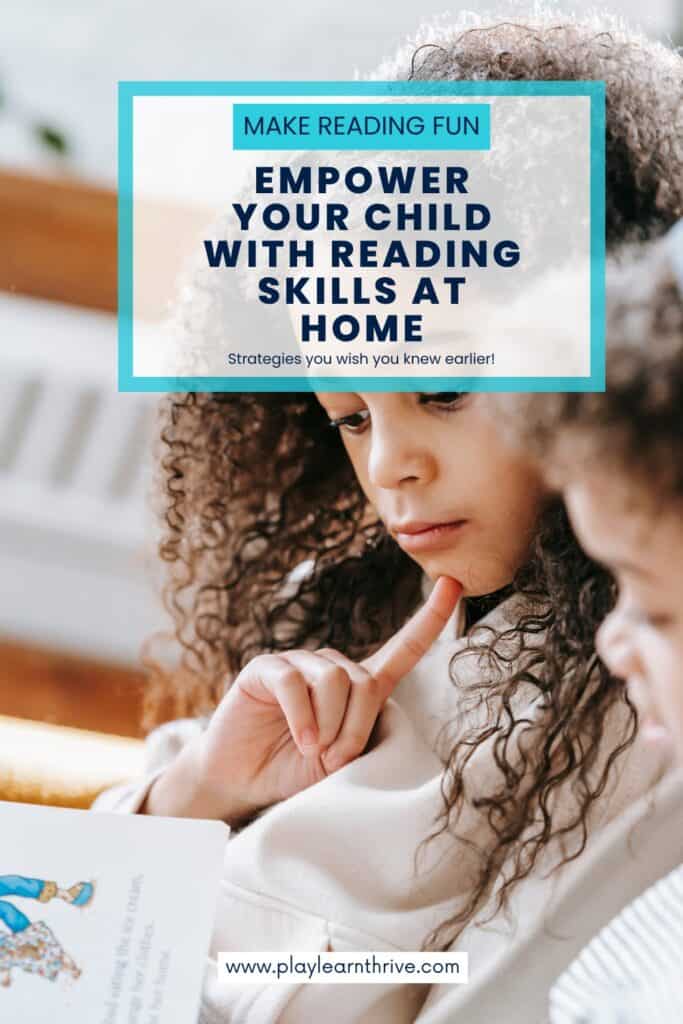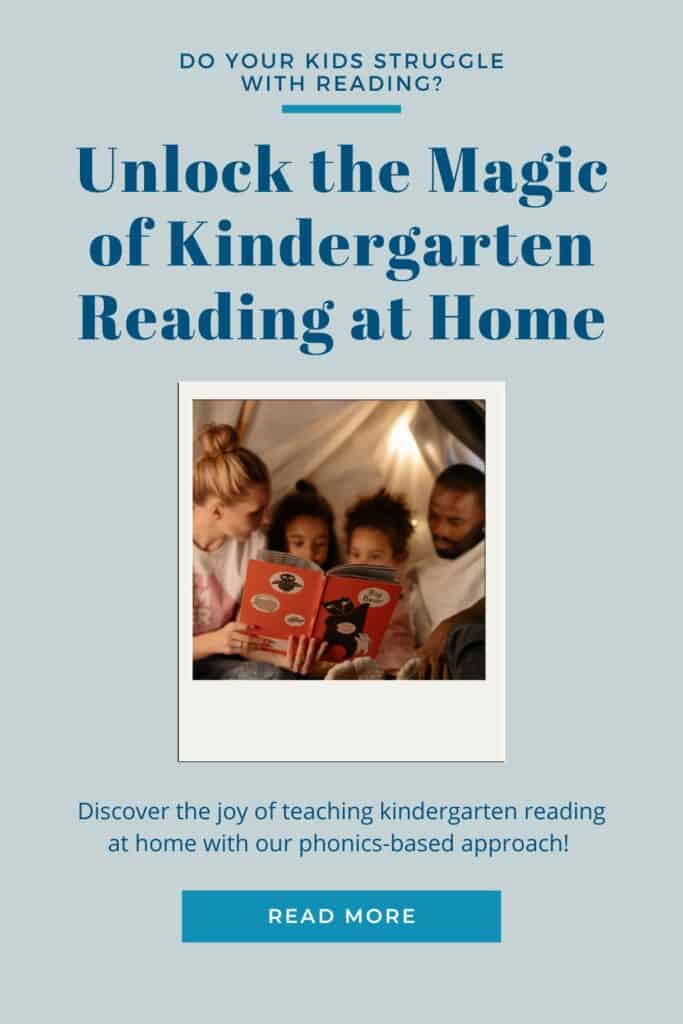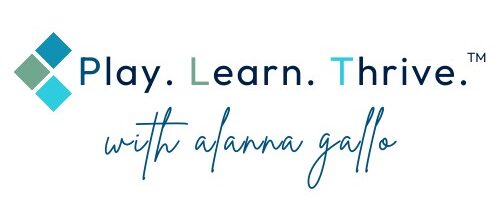How to Teach Reading for Kindergarten at Home: A Gentle, Phonics-Based Approach
In this guide, you’ll discover how to teach reading for kindergarten at home using a phonics-based approach, a literacy-rich environment, hands-on activities, and the power of modeling a love for books.
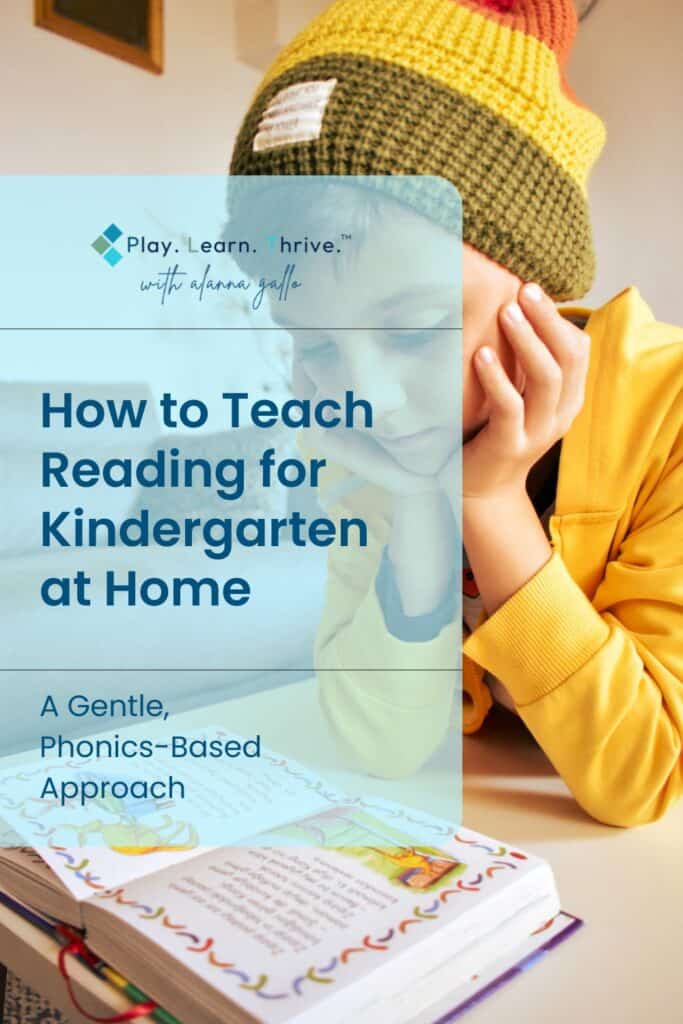
Play. Learn. Thrive.™ only endorses products we authentically love and use. Some of the product links in this post may be affiliate links. That means that if you click them and make a purchase, this site makes a commission. Play. Learn. Thrive.™ is also an Amazon Associate. As an Amazon Associate, we earn from qualifying purchases. It will have no impact on the price you pay or the experience of your purchase.
Welcome back to Play. Learn. Thrive.! I’m Alanna Gallo, a former teacher with a master’s in education who saw firsthand how kids were losing confidence, independence, and their natural love of learning. I left the classroom to help parents raise curious, capable, and screen-conscious kids in a world that doesn’t make it easy.

My work has been featured in major media outlets, and I’m here to give you real, research-backed advice—without the guilt trips or unrealistic expectations.
Teaching your child to read at home may seem like a daunting task, but it doesn’t have to be. The goal isn’t just to get them reading—it’s to cultivate a genuine love for books. When children connect reading with joy, curiosity, and exploration, they’ll naturally want to learn.
The best part? You don’t need a rigid curriculum or daily drills. By making reading a natural, playful part of your daily routine, your child will build strong literacy skills while enjoying the process—without pressure.
How to Teach Reading for Kindergarten at Home: A Gentle, Phonics-Based Approach
Step 1: Create a Literacy-Rich Environment
Before your child even begins decoding words, they need to be surrounded by language. A literacy-rich home is one where books, conversation, and print are a natural part of daily life. Children learn to love reading not just through formal instruction, but by seeing it woven into everyday moments—when they hear stories at bedtime, see you reading a book with your morning coffee, or recognize letters and words in their environment.
The more they interact with words in a meaningful way, the more reading feels like a natural and enjoyable part of life. A home filled with books, storytelling, and engaging discussions helps children develop strong language skills, build vocabulary, and gain the confidence to become independent readers. Even before they recognize letters, they are absorbing the rhythm of language, understanding that words have meaning, and realizing that reading is a gateway to knowledge and adventure.
By fostering a print-rich environment where books are accessible, conversations are encouraged, and storytelling is a daily ritual, you set the foundation for a lifelong love of reading—long before formal lessons begin.

Easy ways to build literacy into your child’s day:
Fill your home with books – Have baskets of books in different rooms and let your child explore them freely. Board books, picture books, and even comic books count!
Label common objects – Use sticky notes to label everyday items like “door,” “chair,” or “sink” to reinforce print awareness.
Sing and rhyme – Nursery rhymes and silly songs build phonemic awareness (a key pre-reading skill). Songs like Down by the Bay or The Itsy Bitsy Spider help kids hear the sounds that makeup words.
Talk about what you read – Make reading interactive by asking open-ended questions like, “What do you think will happen next?” or “How do you think the character feels?”
👀 Let them see YOU reading – Kids model what they see. If you read for enjoyment, they’ll be more likely to see books as a source of fun and relaxation.
When children grow up surrounded by print and language, they start to recognize that words carry meaning—long before they begin formal reading instruction.
Step 2: Start with a Phonics-Based Approach
Instead of memorizing words by sight, a phonics-based approach teaches kids how letters represent sounds, allowing them to decode words rather than rely on rote memorization. This method gives them the essential building blocks of reading—understanding that each letter (or letter combination) corresponds to a specific sound and that blending those sounds together forms words.
Phonics is widely recognized as the most effective way to help children become confident, independent readers because it provides them with a logical system for figuring out unfamiliar words. Rather than guessing based on pictures or remembering whole words, they develop the skills to break words down into their component sounds and sound them out. This approach fosters true reading comprehension and fluency over time, as children gain the ability to read any word they encounter—not just the ones they’ve memorized.
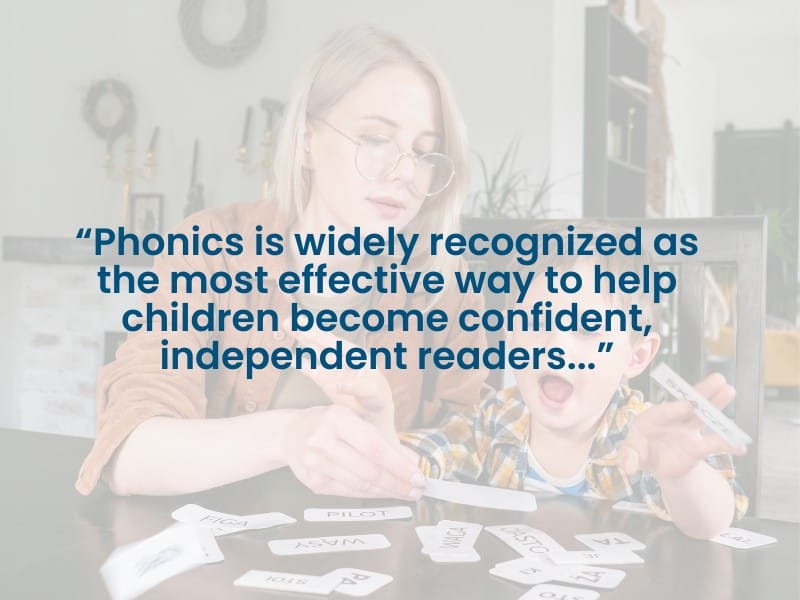
For example, instead of memorizing “cat” as a single word, they learn that C makes the /k/ sound, A makes the /ă/ sound, and T makes the /t/ sound—and when blended together, they form the word cat. This fundamental skill unlocks reading in a way that sight-word memorization alone never could.
By focusing on phonics, you empower your child with the tools to decode words independently, leading to stronger reading fluency, better comprehension, and greater confidence in their ability to tackle new words on their own.
Here’s how to introduce phonics at home:
Focus on letter sounds first – Teach your child that B says /b/, C says /k/, etc. (rather than just naming the letters).
Use multi-sensory activities – Have your child trace letters in sand, form letters with playdough, or write them in shaving cream. We love using sandpaper letters because they help children trace and feel letter shapes while saying the corresponding sound.
Make phonics games part of play – Try a simple “I Spy” game using sounds: “I spy something that starts with /m/ (milk!)”
Use decodable books – These are simple books that reinforce phonics skills (e.g., Sam sat on a mat).
Stretch out sounds in words – Say, “C-A-T… now blend it together: cat!” This helps with phonemic awareness.
By using these playful methods, kids absorb phonics naturally—without needing worksheets or forced lessons.
Step 3: Let Them Learn Through Play and Hands-On Activities
Children learn best by doing, not just by passively listening or memorizing. Reading is no different—when kids engage with letters, sounds, and words in a multi-sensory, playful way, learning becomes an adventure rather than a chore.
Young children thrive when learning is active and engaging, allowing them to touch, move, experiment, and explore. Sitting still and staring at letters on a page can feel abstract and disconnected from real life, but when they can manipulate letters, act out stories, and connect sounds to physical experiences, reading becomes a natural and enjoyable process.
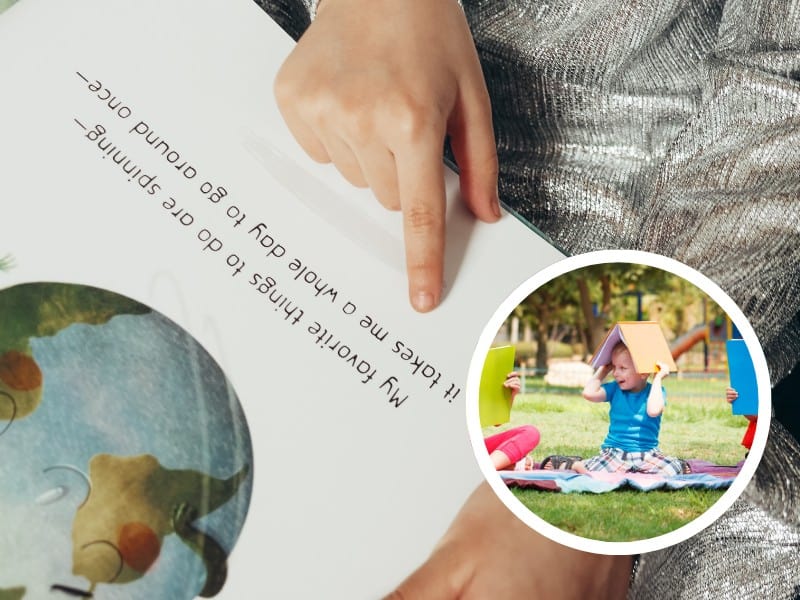
Why Hands-On Learning Works for Reading
It makes abstract concepts tangible – Tracing letters in sand, building words with magnetic letters, or forming letters out of playdough helps children internalize letter shapes and sounds in a way that feels real.
It engages multiple senses – Saying letter sounds aloud, hearing them in songs, and physically moving to find letters (like a scavenger hunt) all reinforce phonics through sight, sound, and touch.
It keeps learning joyful – Games, storytelling, and movement-based activities help prevent frustration and create positive associations with reading. When kids enjoy the process, they’re more motivated to learn.
It strengthens memory and retention – Research shows that when children physically interact with letters and words, they retain the information more effectively than when simply listening or repeating.
Instead of structured “reading lessons” that feel like work, incorporating play-based, hands-on activities allows children to explore literacy at their own pace, without pressure. Reading should feel exciting, empowering, and fun—because when kids enjoy the journey, they’ll naturally want to keep going.
Montessori-Inspired Hands-On Ways to Teach Reading at Home
Moveable Alphabet – Use a Montessori moveable alphabet to help your child build simple words like cat or dog. This hands-on approach allows them to experiment with spelling before they even begin writing.
Sound Object Matching – Gather a basket of small objects (e.g., a tiny cup, toy car, button) and have your child match each item to the letter sound it begins with. This concrete connection between objects and sounds strengthens phonemic awareness.
Letter Sound Walks – Go on a phonics-focused nature walk or scavenger hunt. Say a letter sound (e.g., /b/) and let your child find something in their environment that starts with that sound (bird, book, bench).
Story Reenactment with Props – Instead of just acting out a book, provide simple props (a hat, stuffed animal, toy food) and invite your child to retell the story in their own words. This supports comprehension, sequencing, and oral storytelling skills.
Sandpaper Letters & Tracing – Use Montessori sandpaper letters to help children trace and feel letter shapes while saying the corresponding sound. Follow up with tracing letters in a salt tray, which supports sensory integration.
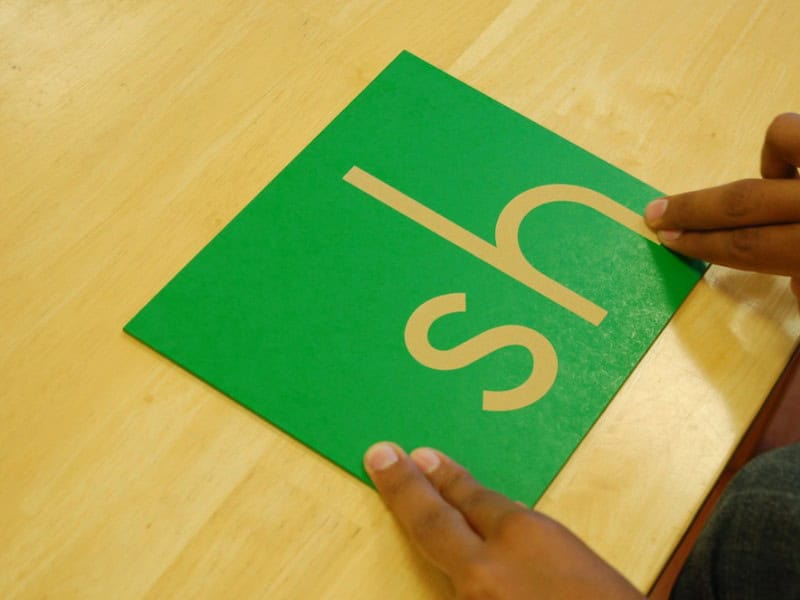
Everyday Labeling – Instead of labeling items for them, encourage your child to write their own labels for common household objects (with support as needed). This builds ownership and reinforces real-world reading connections.
By incorporating self-directed, tactile, and real-world learning, you help your child develop reading skills in a joyful, pressure-free way that aligns with their natural curiosity and developmental stage.
Step 4: Follow Their Lead—No Pressure!
One of the biggest mistakes parents make is pushing children to read before they are developmentally ready. Reading is a complex process that requires a combination of phonemic awareness, cognitive development, fine motor skills, and emotional readiness—all of which unfold at different times for each child.
Many children show early interest and begin recognizing letters and sounds at 3 or 4 years old, while others may not fully engage with reading until 6 or even 7. And that’s completely okay.
In fact, in many European countries, formal reading instruction doesn’t begin until age 6 or 7 because research supports the idea that forcing early reading can lead to frustration rather than fostering a love for books. A child who is not yet ready to decode words but is pressured to do so may start to associate reading with stress, self-doubt, or failure—rather than joy and discovery.
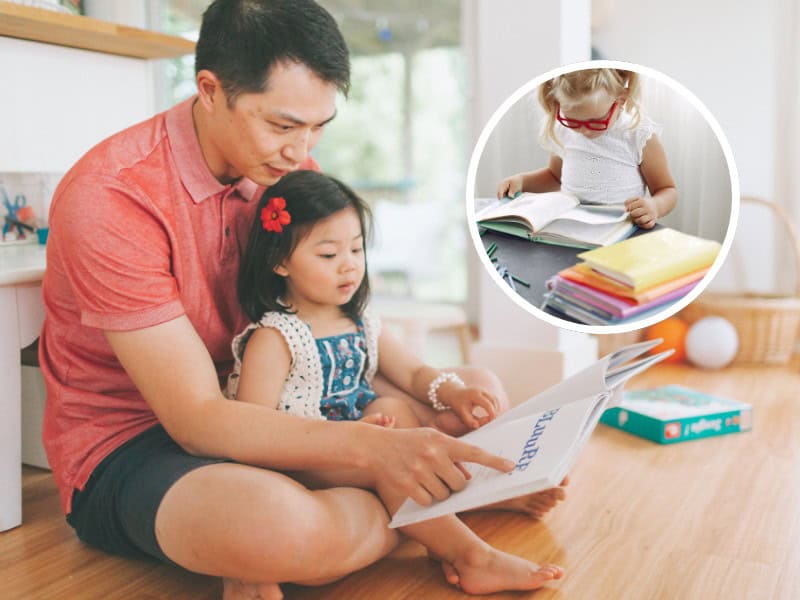
Why Readiness Matters
Every child’s brain develops on its own timeline – Some children may master letter sounds early, while others need more time for auditory processing and memory to develop.
Interest is key to intrinsic motivation – When a child is genuinely curious about words, they are far more likely to engage with reading joyfully and retain what they learn.
Emotional readiness plays a role – A child who feels pressure or compares themselves to peers may resist reading altogether, whereas a child given space and encouragement will often naturally gravitate toward literacy when they’re ready.
Strong pre-reading skills build a better foundation – Before a child can read, they must develop phonemic awareness, vocabulary, listening skills, and comprehension. Rushing into reading too early may bypass these critical steps, leading to struggles later on.
Instead of worrying about when your child should be reading, focus on creating a literacy-rich environment, modeling a love for books, and engaging in hands-on pre-reading activities.
Signs your child is ready to start learning to read:
✔ Begins to recognizes letters and their sounds
✔ Enjoys looking at books and “pretend reading”
✔ Can identify rhyming words
✔ Shows curiosity about words and letters
But if they’re not quite there yet, don’t stress! Keep reading aloud, playing with sounds, and letting them explore books. The worst thing you can do is force reading and make it feel like a frustrating experience.
Instead, focus on making reading a joyful, relaxed, and pressure-free process.

50 Simple Screen-Free Learning Activities for Curious Kids
These 50 hands-on activities help children develop problem-solving skills, creativity, and real-world knowledge—without needing a screen. Designed to encourage self-directed play, hands-on discovery, and deep learning, this guide gives you a simple way to turn everyday moments into powerful learning opportunities.
Step 5: Model a Love of Reading Every Day
If you want your child to love reading, they need to see YOU loving it too! Children learn through observation, and the best way to encourage a passion for books is to model that same enthusiasm yourself. When kids see reading as something their parents genuinely enjoy—not just something they “have to do”—they naturally begin to view it as a pleasurable and valuable activity.
Why Modeling a Love for Reading Matters
Children imitate what they see – If they regularly see you curled up with a good book, flipping through a magazine, or reading a recipe while cooking, they start to recognize that reading is part of daily life—not just a school task.
It normalizes reading as a lifelong habit – In a world filled with digital distractions, showing your child that reading is a natural, enjoyable activity reinforces that books are something to be cherished and prioritized.
It sparks curiosity and conversation – When children see parents engaged in reading, they often ask, “What’s your book about?” or “Why do you like that story?” These moments of curiosity open the door for meaningful discussions about books, ideas, and the joy of storytelling.
It fosters deeper connections – Reading aloud together and talking about books creates shared experiences, strengthens family bonds, and encourages children to think critically about stories.
Ways to Model a Love for Reading
Make reading part of your routine – Whether it’s morning coffee with a book, winding down with a novel at night, or flipping through a cookbook together, let your child see that reading is a natural part of your life.
Fill your home with books – Keep a variety of books visible and easily accessible in different rooms. Seeing books everywhere reinforces their importance.
Talk about what you're reading – Share fun facts from a nonfiction book, discuss an interesting plot twist, or say something like, “I can’t wait to see how this story ends!” to show excitement and engagement.
Let your child “catch you” reading – Instead of only reading when your child is asleep or occupied, take moments to read during the day when they can see you enjoying a book.
Include books in everyday activities – Read street signs, grocery lists, menus, and even instructions for building a new toy together. Show your child that reading is not just for stories—it’s a vital skill used in daily life.
Make library visits a family ritual – Instead of just taking your child to pick out books, select one for yourself too! Show them that the library isn’t just a place for kids—it’s a space for everyone to discover and explore new ideas.
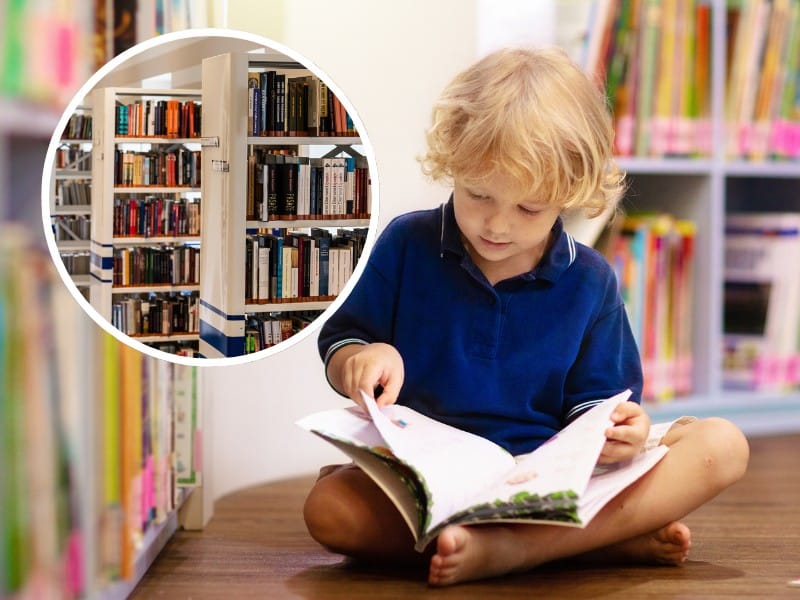
By modeling a genuine love for reading, you create an environment where books are seen as exciting, enjoyable, and valuable. Over time, this simple but powerful habit helps your child naturally develop their own passion for reading, setting them up for a lifetime of literacy and learning.
Final Thoughts: Keep It Simple, Fun, and Pressure-Free
If you’re wondering how to teach reading for kindergarten at home, remember:
- Make your home a print-rich environment (books, conversations, and play-based literacy).
- Use a phonics-first approach (teaching sounds before memorizing words).
- Incorporate hands-on activities (learning through play).
- Follow your child’s lead (no rush, no pressure).
- Model reading daily (kids copy what they see).
By keeping the experience gentle, engaging, and child-led, you’ll help your child develop the skills they need to read—without sacrificing their natural love for learning.
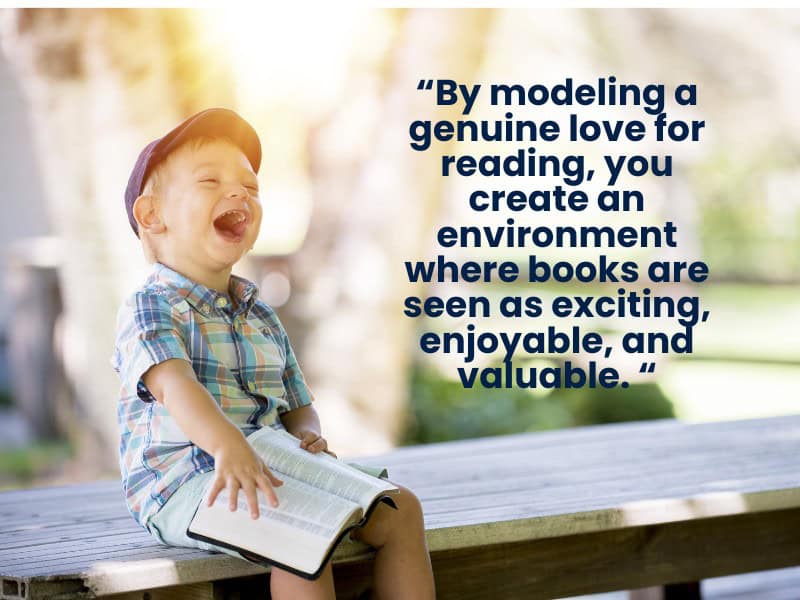
And when they’re finally ready to sound out that first word? You’ll get to witness the pure magic of watching them unlock the world of reading.
Inspired by this post? Be sure to subscribe download my free Screen-Free Starter Kit! For more insights and resources on raising confident, lifelong learners, be sure to follow me on Instagram – can't wait for you to join me!


